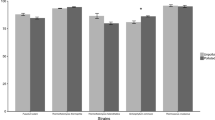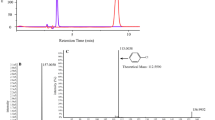Abstract
The aim of this study was to examine how plant terpenoids, as natural growth substrates or inducers, would affect the biodegradation of PCB congeners. Various PCB degraders that could grow on biphenyl and several terpenoids were tested for their PCB degradation capabilities. Degradation activities of the PCB congeners, 4,4′-dichlorobiphenyl (4,4′-DCBp) and 2,2′-dichlorobiphenyl (2,2′-DCBp), were initially monitored through a resting cell assay technique that could detect their degradation products. The PCB degraders,Pseudomonas sp. P166 andRhodococcus sp. T104, were found to grow on both biphenyl and terpenoids ((S)-(−) limonene,p-cymene and α-terpinene) whereasArthrobacter sp. B1B could not grow on the terpenoids as a sole carbon source. The B1B strain grown on biphenyl exhibited good degradation activity for 4,4′-DCBp and 2,2′-DCBp, while the activity of strains P166 and T104 was about 25% that of the B1B strain, respectively. Concomitant GC analysis, however, demonstrated that strain T104, grown on (S)-(−) limonene,p-cymene and α-terpinene, could degrade 4,4′-DCBp up to 30%, equivalent to 50% of the biphenyl induction level. Moreover, strain T104 grown on (S)-(−) limonene, could also degrade 2,2′-DCBp up to 30%. This indicates that terpenoids, widely distributed in nature, could be utilized as both growth and/or inducer substrate(s) for PCB biodegradation in the environment.
Similar content being viewed by others
References
Brown, J. F., Jr., R. E. Wagner, H. Feng, D. L. Bedard, M. J. Brennan, J. C. Carnahan, and R. J. May (1987) Environmental dechlorination of PCBs.Environ. Toxicol. Chem. 6: 579–593.
Bedard, D. L., M. L. Haberl, R. J. May, and M. J. Brennan (1987) Evidence for novel mechanism of polychlorinated biphenyl metabolism inAlcaligenes eutrophus H850.Appl. Environ. Microbiol. 53: 1103–1112.
Focht, D. D. and W. Brunner (1985) Kinetics of biphenyl and polychlorinated biphenyl metabolism in soil.Appl. Environ Microbiol. 50: 1058–1063.
Harkness, M. R. J. B. McDermott, D. A. Abramowicz, J. J. Salvo, W. P. Flanagan, M. L. Stephens, F. J. Mondello, R. J. May, J. H. Lobos, K. M. Carroll, A. A. Bracco, K. M. Fish, G. L. Warner, P. R. Wilson, D. K. Dietrich, D. T. Lin, C. B. Morgan, and W. L. Gately (1993)In situ stimulation of aerobic PCB biodegradation in Hudson River sediments.Science 259: 503–507.
Hernandez B. S., S. Koh, M. Chial, and D. D. Focht (1997) Terpene-utilizing isolates and their relevance to enhanced biotranformation of PCBs in soil.Biodegradation 8: 153–158.
Lewis, R. J., Sr. (1989)Sax’s Dangerous Properties of Industrial Materials, 8th ed. van Nostrand Reinhold, New York, NY, USA.
Robinson, G. K. and M. J. Lenn (1994) The bioremediation of polychlorinated biphenyls (PCBs): problems and perspectives.Biotechnol. Genet. Eng. Rev. 12: 139–188.
Focht, D. D. (1995) Strategies for the improvement of aerobic metabolism of polychlorinated biphenyls.Curr. Opt. Biotechnol. 6: 341–346.
Donnelly, P. K., R. S. Hegde, and J. S. Fletcher (1994) Growth of PCB-degradaing bacteria on compounds from photosynthetic plants.Chemosphere 28: 981–988.
Fletcher, J. S., P. K. Donnelly, and R. S. Hegde (1995) Plant assisted poly-chlorinated biphenyl (PCB) biodegradation. In:Proceedings of the 14th Annual Symposium on Current Topics in Plant Biochemistry, Physiology and Molecular Biology. University of Missouri-Columbia, Columbia, MO, USA.
Furukawa, K. (1994) Molecular genetics and evolutionary relationship of PCB-degrading bacteria.Biodegradation 5: 289–300.
Higson, F. K. (1992) Microbial degradation of biphenyl and its cerivatives.Adv. Appl. Microbiol. 37: 135–164.
Gilbert, E. S., and D. E. Crowley (1997) Plant compounds that induce polychlorinated biphenyl biodegradation byArthrobacter sp. strain B1B.Appl. Environ. Microbiol 63: 1933–1938.
Burdock, G. A. (1995)Fenaroli’s Handbook of Flavour Ingredients 3rd ed., pp. 107. CRC Press, Boca Raton. FL, USA.
Arensdorf, J. J. and D. D. Focht (1995) A meta cleavage pathway for 4-chloro-benzoate, an intermediate in the metabolism of 4-chlorobiphenyl byPseudomonas cepacia P166.Appl. Environ. Microbiol. 61: 443–447.
McCullar, M. V., V. Brenner, R. H. Adams, and D. D. Focht (1994) Construction of a novel polychlorinated biphenyl-degrading bacterium: utilization of 3,4′-dichlorobiphenyl byPseudomonas acidovorans M3GY.Appl. Environ.Microbiol. 60: 3833–3839.
Focht, D. D. (1995) Aerobic Biotransformations of Polychlorinated Biphenyls. pp. 811–814. In Hurst, C. J., G. R. Knudsen, M. J. McInerney, L. D. Stetzenbach and M. V. Walter,Manual of Environmental Microbiology, ASM Press, Washington, DC, USA.
Park, Y. I., J. S. So, and S. C. Koh (1999) Induction by carvone of polychlorinated biphenyl(PCB)-degradative pathway inAlcaligenes eutrophus H850 and its molecular monitoring.J. Microbiol. Biotechnol. 9: 804–810.
Seeger, M., K. N. Timmis, and B. Hofer (1995) Coriversion of chlorobiphenyls into phenylhexadienoates and benzoates by the enzymes of the upper pathway for polychloro-biphenyl degradation encoded by the bph locus ofPseudomonas sp. strain LB400.Appl. Environ. Microbiol. 61: 3353–3358.
Arnett C. M., J. V. Parales, and J. D. Haddock. (2000) Influence of chlorine sub-stitiuents on rates of oxidation of chlorinated biphenyls by the biphenyl dioxygenase ofBurkholderia sp. strain LB400.Appl. Environ. Microbiol. 66: 2928–2933.
Bedard, D. L., R. E. Wagner, M. J. Brennan, M. L. Haberl, and J. F. Brown, Jr. (1987) Extensive degradation of aroclors and environmentally transformed polychlorinated biphenyls byAlcaligenes eutrophus H850.Appl. Environ Microbiol. 53: 1094–1102.
Ahmad, D., R. Masse, and M. Sylvestre (1990) Cloning and expression of genes involved in 4-chlorobiphenyl transformation byPseudomonas testosteroni: Homology to polychlorobiphenyl-degrading genes in other bacteriaGene 86: 53–61.
Koh, S.-C., Y. I. Park, Y. M. Koo, and J. S. So (2000) Flant terpenes and lignin as natural cosubstrates in biodegradation of polychlorinated biphenyls (PCBs) and polycyclic aromatic hydrocarbons (PAHs).Biotechnol. Bioprocess Eng. 5: 164–168.
Author information
Authors and Affiliations
Corresponding author
Rights and permissions
About this article
Cite this article
Jung, KJ., Kim, E., So, JS. et al. Specific biodegradation of polychlorinated biphenyls (PCBs) facilitated by plant terpenoids. Biotechnol. Bioprocess Eng. 6, 61–66 (2001). https://doi.org/10.1007/BF02942252
Received:
Accepted:
Issue Date:
DOI: https://doi.org/10.1007/BF02942252




